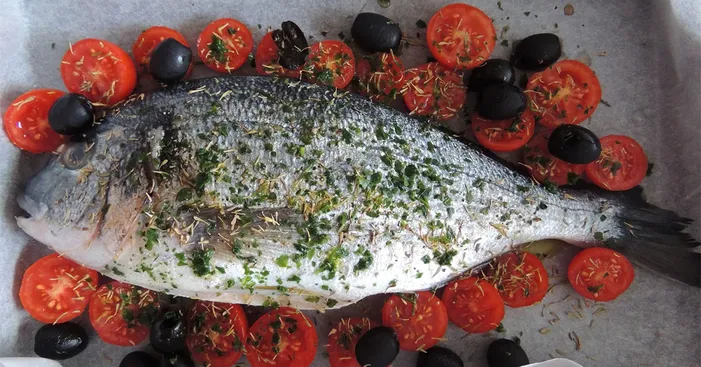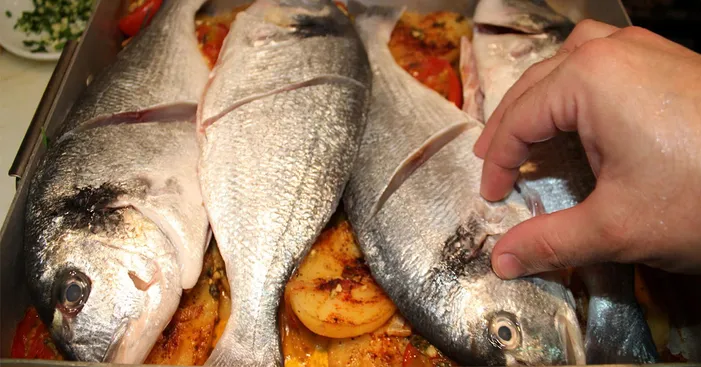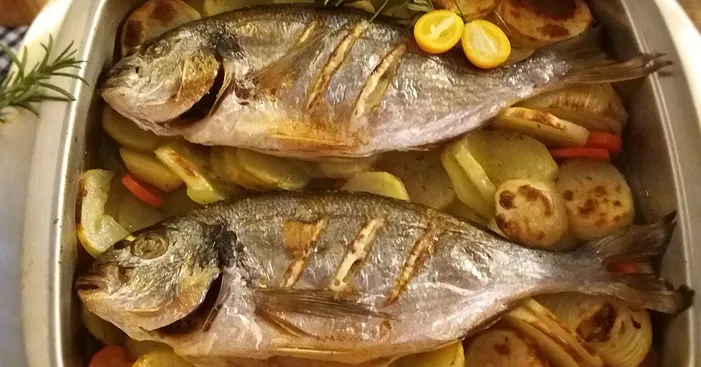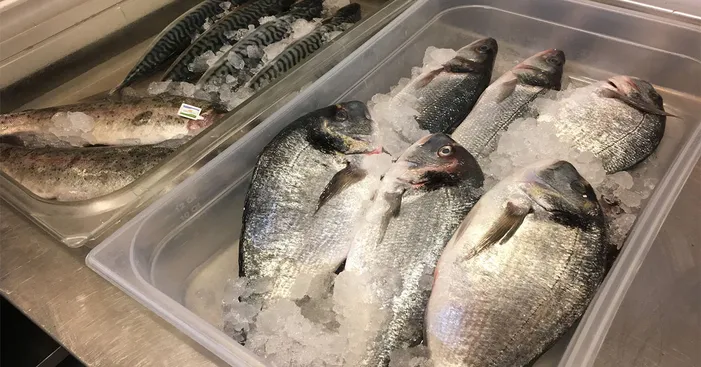Table of Contents

Sea bream is a delicious and versatile fish that is also packed with health benefits.
It is a good source of protein, vitamins, and minerals, and it is low in calories and saturated fat.
Sea bream is also a good choice for people who are looking for a sustainable seafood option.
In this blog post, we will take a closer look at the many benefits of sea bream and how to incorporate it into your diet.
We will also share some delicious and easy-to-make sea bream recipes.
General facts about Sea Bream:

What is Sea Bream:
The Sea Bream, or doraba, is a nutrient-rich fish that is a staple of the Mediterranean diet.
It is considered one of the most exquisite fish and is recommended for simple culinary preparations, such as grilling, steaming, or baking.
The Sea Bream is an oval, compressed fish with thick lips and jaws armed with conical teeth and molars.
It has a broad, powerful tail that enables it to swim quickly.
At the beginning of their sexual maturity, all specimens are males, becoming females as they grow in size.
The Sea Bream is characterized by its silver color, which fades towards the belly and becomes pinkish or even whitish.
It has a golden spot between the eyes, reddish spots on the cheeks, and black spots on the operculum.
The coloration of farmed sea bream is more subdued than that of wild sea bream.
The main producing countries of sea bream are Greece, Turkey, Spain, and Italy.
To a lesser extent, Portugal, Egypt, Israel, France, Croatia, Cyprus, Malta, Egypt, Tunisia, and Morocco also produce sea bream.
Although extractive bream continues to be unloaded in fishing ports, the volume of farmed bream already represents 92% of the total.
Sea bream is farmed in most Mediterranean countries and on some Atlantic coasts.
This practice has been developed since Roman times, and thanks to it, we can enjoy this fish all year round.
Farmed fish has the advantage of arriving on the market very fresh, without suffering the depletion that fishing entails, but it has the disadvantage that its meat is softer and less tasty than that caught at sea.
Types of Sea Bream:

Wild sea bream and farmed sea bream are two different types of the same fish.
Wild sea breams are born and raised in the ocean, while farmed sea breams are raised in captivity.
This difference in habitat leads to several other differences, including taste, appearance, availability, and price.
Wild sea bream is generally considered to have a better flavor than farmed sea bream.
This is because wild sea breams have a more varied diet, which includes fish, mollusks, crustaceans, algae, and green marine plants.
Farmed sea breams, on the other hand, are typically fed a diet of high-performance feeds.
Wild sea breams are also typically thinner and less plump than farmed sea breams.
They also have a yellow spot on their heads, while farmed sea bream have greyish-black heads.
Wild sea breams are only available during certain months of the year, while farmed sea breams are available year-round.
Wild sea bream is typically more expensive than farmed sea bream.
This is because wild sea bream is more difficult to catch and transport.
Ultimately, the best type of sea bream to buy is a matter of personal preference.
If you are looking for the best flavor and quality, then wild sea bream is the way to go.
However, if you are looking for a more affordable and readily available option, then farmed sea bream is a good choice
Sea bass vs sea bream:

Sea bass and sea bream are two of the most popular fish in Spanish cuisine.
They’re both white, mild-flavored, and versatile, making them perfect for a variety of dishes.
But which fish is the better choice?
In the corner of the ring, we have the sea bass.
Sea bass is a lean fish with high protein content and low-fat content.
It’s also a good source of omega-3 fatty acids, which are beneficial for heart health.
In the other corner, we have the sea bream.
Sea bream is also a lean fish, but it has a slightly higher fat content than sea bass.
It’s also a good source of protein and omega-3 fatty acids.
So, which fish is the better choice? It really depends on your individual needs and preferences.
If you’re looking for the leanest fish with the lowest fat content, then sea bass is the better option.
But if you’re looking for a fish with a slightly more complex flavor, then sea bream is a good choice.
Here are the main differences:
Appearance:
Sea bass is a stocky fish with a large head and a silvery-gray body.
It has two distinct dorsal fins, and its tail fin is forked.
Sea bream is a more slender fish with a smaller head and a silvery-blue body.
It also has two dorsal fins, but its tail fin is rounded.
Flavor:
Sea bass has a mild, slightly sweet flavor.
Sea bream has a slightly more pronounced flavor, with a hint of saltiness.
Texture:
Sea bass has a delicate, flaky texture.
Sea bream has a firmer, more meaty texture.
Sea Bream nutritional values and health benefits:

Nutritional values:
Sea bream is a delicious and nutritious fish that offers a wide range of health benefits.
It is a good source of high-quality protein, omega-3 fatty acids, vitamins, and minerals.
Protein
Sea bream is a good source of high-quality protein, which is essential for the growth, maintenance, and repair of body tissues.
Protein is also required for the production of enzymes, hormones, and antibodies.
Omega-3 Fatty Acids
Sea bream is a good source of omega-3 fatty acids, such as eicosapentaenoic acid (EPA) and docosahexaenoic acid (DHA).
These fatty acids are known for their beneficial effects on heart health, brain health, and inflammation.
Vitamins and Minerals
Sea bream is a good source of B vitamins, such as niacin, vitamin B6, and vitamin B12, which are essential for energy metabolism, the nervous system, and the formation of red blood cells.
It also contains minerals such as potassium, phosphorus, selenium, and magnesium, which play an important role in several bodily functions, including bone health, the immune system, and the regulation of heart rhythm.
Health benefits:

Sea bream offers several health benefits due to its nutritional composition, such as:
- Reduced risk of heart disease: The omega-3 fatty acids in sea bream can help reduce inflammation, improve artery health, and help regulate blood cholesterol levels.
- Improved brain function: The omega-3 fatty acids in sea bream are essential for brain health and may promote good cognitive function.
- Stronger bones and teeth: The phosphorus in sea bream is essential for healthy bones and teeth.
- Boosted immune system: The selenium in sea bream supports the immune system.
- Reduced risk of chronic diseases: The antioxidants in sea bream can help protect cells from damage and reduce the risk of chronic diseases such as cancer and heart disease.
- Arthritis: The omega-3 fatty acids in sea bream may help reduce inflammation and joint pain in people with arthritis.
- Diabetes: Sea bream is a good source of protein and low in carbohydrates, making it a healthy choice for people with diabetes.
- Obesity: Sea bream is a low-calorie and high-protein food, which can help promote weight loss and weight management.
Other health benefits:
- Reduces the risk of cancer.
- Keeps you fit and trim.
- Fights cognitive decline.
- Protects against Alzheimer’s disease.
- promotes healthy bones and teeth.
- Strengthens the immune system.
- Protects the heart and arteries.
- Improves blood circulation.
- Prevents cell aging.
- Reduces stress, anxiety, and depression.
Precautions before you consume Sea Bream:

Sea bream is a delicious and popular fish, but it is important to be aware of a few potential risks before consuming it.
Allergies
Some people may be allergic to fish, including sea bream.
Allergic reactions can range from mild to severe, so it is important to be cautious if you have a history of fish allergies.
Mercury Contamination
Sea bream, like many fish, may contain traces of mercury.
Mercury is a heavy metal that can be harmful to health if consumed in large quantities.
Pregnant women, nursing mothers, and young children are particularly sensitive to mercury, so they should limit their consumption of sea bream and other high-mercury fish.
Parasites
Sea bream, like many fish, can harbor parasites, such as worms or larvae.
It is important to cook the fish thoroughly to kill any parasites.
Environmental Contamination
Sea bream can be exposed to environmental pollutants, such as pesticides or heavy metals, due to the increasing presence of pollutants in the oceans and waters where they are raised.
However, controlled aquaculture can reduce the risk of contamination.
Drug Interactions
Some compounds found in sea bream may interact with certain medications.
If you are taking any medications, it is important to talk to your doctor before consuming sea bream.
Overall, sea bream is a safe and healthy food for most people.
However, it is important to be aware of the potential risks and take precautions to minimize them.
Using Sea Bream:

There are many ways to use Sea Bream in your recipe including:
- Sea bream is a versatile fish that can be cooked in many different ways.
- Fillets can be steamed, poached, braised in white wine, or pan-fried with olive oil and fresh herbs.
- Whole sea bream can be baked, barbecued, grilled on a spit, en papillote, fried, or poached.
- Its delicate white flesh is perfect for sushi and sashimi.
- Sea bream goes very well with lemony, spicy sauces, and can also be eaten in tomato sauce.
It is also used in many traditional dishes, such as zarzuela, paella, and other fish soups. - A delicious way to cook sea bream is “à la meunière”, which means to flour and pan-fry the fish in butter, then serve it with lemon wedges.
- Another option is to stuff the cavity of the fish with a mixture of your choice of herbs and preserved lemons, chopped vegetables, small shrimps, and so on.
Tie up the fish so that the stuffing doesn’t escape, and bake to your liking.
Sea bream with Gratin, Breadcrumbs and Tomato Compote:

Ingredients:
- 4 boneless sea bream loins, 250 grams each
- 1 sprig of thyme
- 1 onion
- 1 kilogram of natural tomatoes
- 150 milliliters of virgin olive oil
- 1 teaspoon sugar
- Chives
- Breadcrumbs
- Chopped parsley and salt
Preparation:
- Preheat the oven to 200 degrees Celsius.
- Bring a pot of water to a boil.
Blanche the tomatoes in the boiling water for a few seconds, then quickly cool them, peel them, and cut them into small cubes.
Reserve two tomatoes for the vinaigrette. - Julienne the onion and sauté with the thyme in a frying pan with a little bit of olive oil until softened.
Add the chopped tomatoes and season with salt.
Now add the sugar and cook over low heat until the tomatoes are well done. - Season the reserved tomatoes with olive oil, chopped chives, and salt.
- Score the bream loins on both sides with a sharp knife. Season with salt and pepper.
- Heat a frying pan over medium heat with a little bit of olive oil.
Place the bream loins in the pan and cook for 2-3 minutes per side, or until just cooked through. - To make the crust, combine the breadcrumbs, chopped parsley, and a few drops of olive oil in a small bowl.
- Place the bream loins on a baking sheet.
Sprinkle the crust mixture over the top of the fish. - Bake the bream for 5 minutes, or until the crust is golden brown.
- To serve, spread the tomato compote over the bottom of a plate.
Place the bream loin on top of the compote and drizzle with the reserved tomato vinaigrette.
Buying Sea Bream:

There are several ways to know if Sea Bream is fresh or not, here are some tips:
- Firm flesh:
Press down on the flesh of the fish.
If it bounces back quickly, it is fresh.
If it is soft or indented, it is not fresh. - Bright red gills:
The gills should be a bright red color.
If they are brown or slimy, the fish is not fresh. - Bright, clear eyes:
The eyes should be bright and clear, not sunken or with whitish spots.
If the eyes are cloudy or dull, the fish is not fresh. - Slightly pronounced sea smell:
The fish should have a slightly pronounced sea smell.
If it has a strong fishy smell, it is not fresh.
Storing sea bream:

If you’re going to eat your sea bream within 24 hours, store it in the coldest part of the fridge, gutted and clean.
For longer storage, freeze it for up to 5 months.
No matter how you store it, refrigerate your sea bream within 48 hours of purchase, gut, clean, and isolate from other foods to prevent cross-contamination.
Here are some additional tips for storing sea bream:
- Wrap the fish tightly in plastic wrap or foil before storing it in the fridge or freezer.
- Label the fish with the date of purchase and the best-by date.
- If you’re freezing the fish, consider portioning it out into individual servings so that you can thaw only what you need.
- Thaw frozen fish in the fridge overnight or under cold running water for 30 minutes per pound.
